Using time frames, you can tell the system about the times when your office is open, closed, or celebrating a holiday.
Time frames do not go into effect until you apply a time frame to an answering rule or IVR greeting. When the time frames are applied, the first matching time frame becomes active.
Displaying the Time Frames Page
All time frame tasks are performed from the Time Frames page. To display this page, click the Time Frames icon on the menu bar:

The following figure shows an example of the Time Frames page.

A search field at the top-left of the page allows you to review a specific user's personal time frames by entering a user time frame and then clicking the magnifying glass icon:

The 
 button at the top-right side of the page refreshes the information on the page.
button at the top-right side of the page refreshes the information on the page.
|
Where to go from here: From the Time Frames page, you can:
|
|---|
Working With Time Frames
When you create a new time frame, you assign a unique name to it and then specify one of the following times associated with the time frame:
- Always = time frame applies to all hours of every day (24/7/365).
- Days of the week and times = commonly used to define office open hours such as Monday - Friday 9am - 5pm. Each day has its own check box. Check the days to which the time frame will be applied and then use slide bars to define the time ranges for each checked day.
-
Specific dates or ranges = commonly used to define holidays or other special events such as New Year or a training course. Use pop-up calendars to select the To and From dates when the time range will apply.
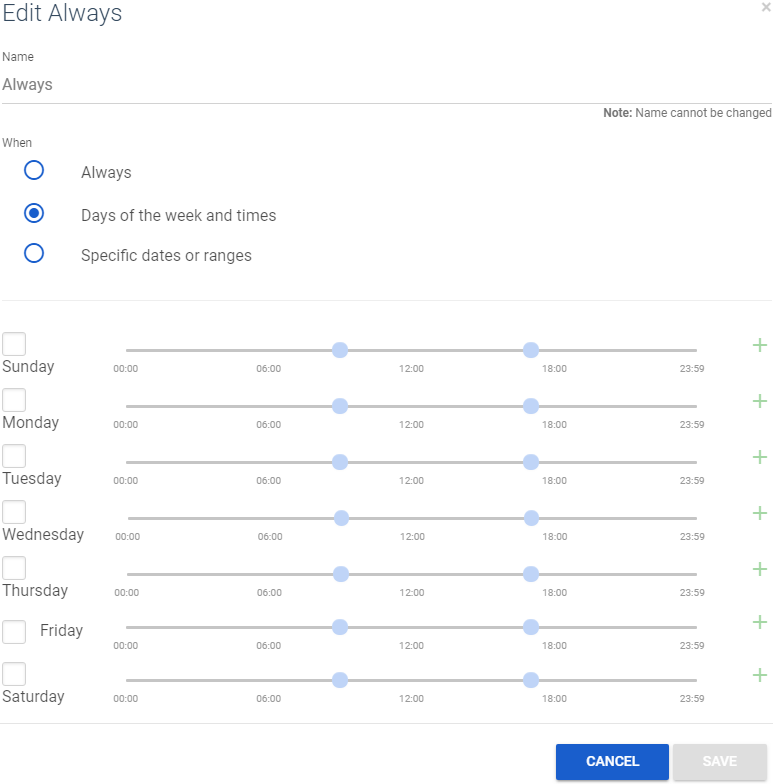
When you check a check box, a blue control bar covers the times 9AM to 5PM for that day. Drag this control to change the time according to your requirements. If you need to add more ranges for a day, click the following icon to the right of the time range: 
-
Specific dates or ranges = allows you to specify a time range for the time frame by selecting starting and ending dates from a pop-up calendar.
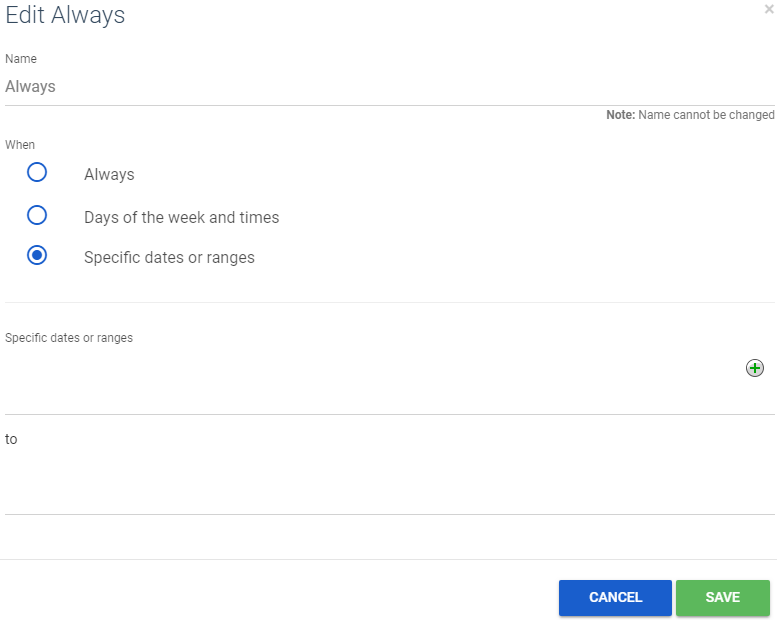
The following example shows a time frame called Open Hours, which covers 9AM to 5PM hours for the days Monday through Friday.
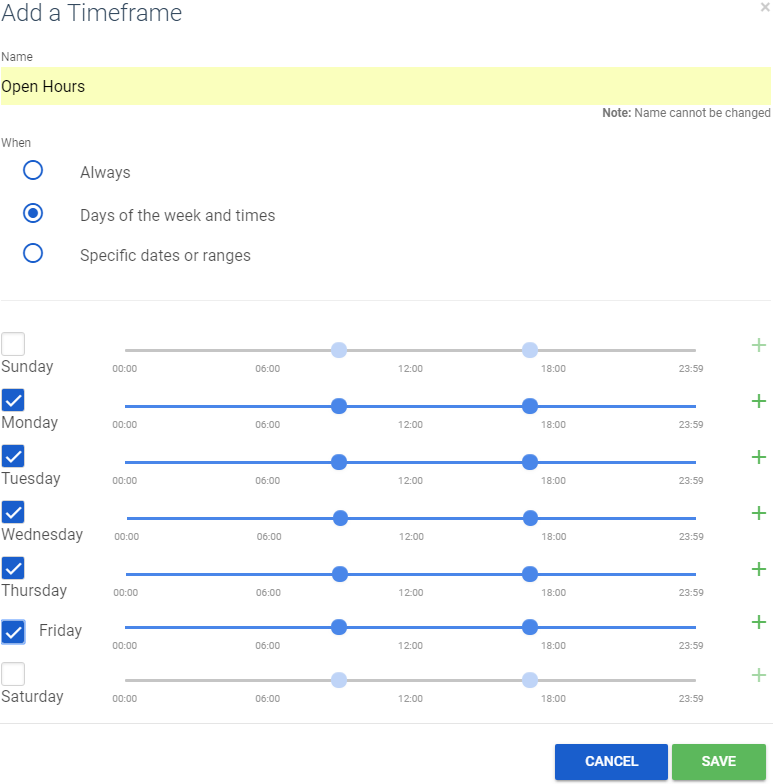
This time frame might be used with another time frame called Holiday, which covers holiday periods. You might even create a time frame called Closed Hours (default already exists), which would be an 'Always' rule, but would not always be active since it can be set for lower priority than Holiday or Open Hours.
Adding Time Frames
To add time frames:
- From the Time Frames page, click the Add Time Frame button. The Add a Timeframe pop-up window appears.
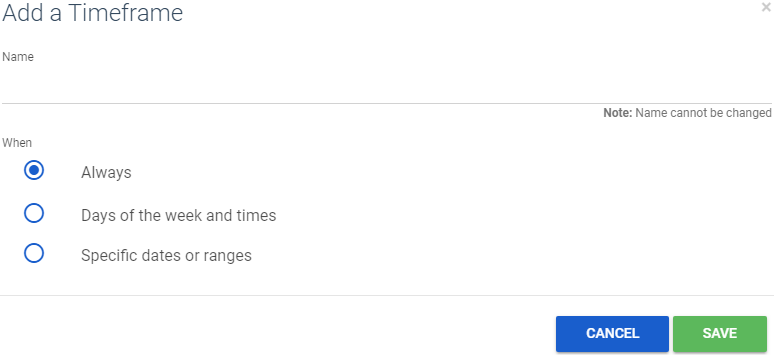
- Complete the fields (see Table 8-1).
Table 8-1. Adding/Editing Time Frame Settings
| Setting | Description |
|---|---|
| Name |
Adding a time frame: Enter a name for this time frame. The name should allow you to differentiate this time frame from other time frames you configured. Editing a time frame: read-only field that shows the name of the time frame. |
| When |
Select when the time frame will be applied. Choices are:
|
.png)
Figure 8-1. Configuring Days of the Week
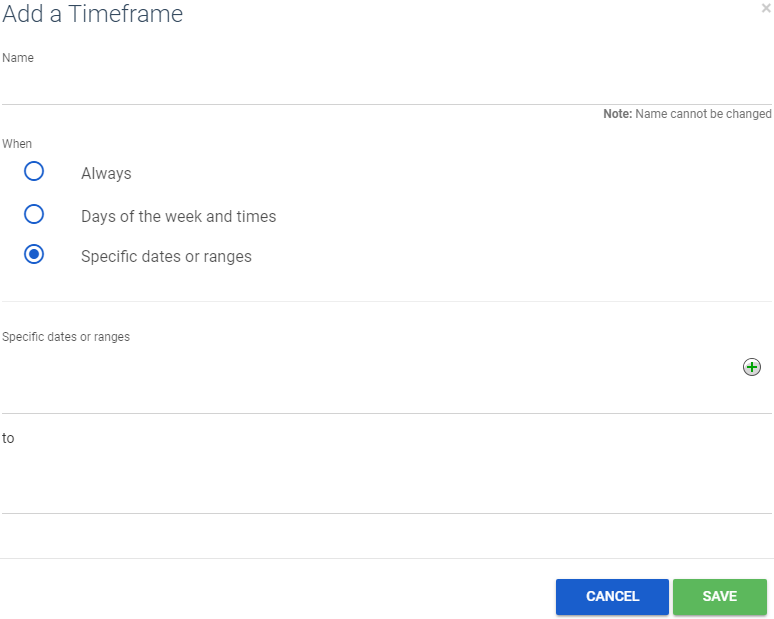
Figure 8-2. Configuring Specific Dates or Ranges
3. Click Save.
Editing Time Frames
There might be times when you need to edit time frames. For example, you might want to change when they occur.
- From the Time Frames page, either:
- Click a name OR
- Hover over a name and then click the
 icon at the far right of the Time Frames page.
icon at the far right of the Time Frames page.
Either step displays the Edit pop-up window. For example: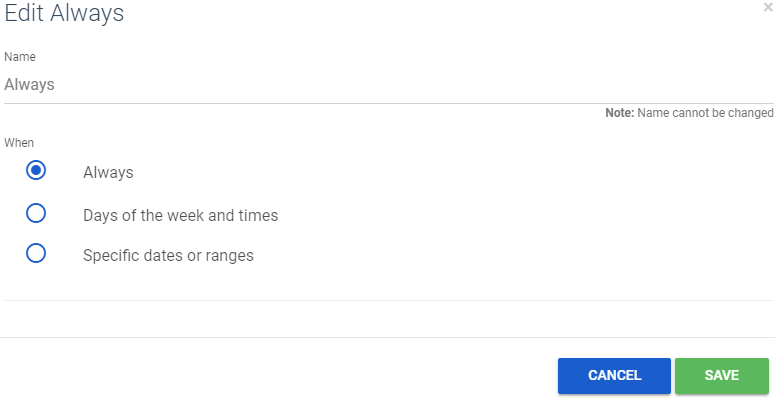
- Complete the fields (see Table 8-1).
- Click Save.
Deleting Time Frames
If you no longer need a time frame, you can delete it from the system.
- From the Time Frames page, hover over the time frame and then click the
 icon at the far right of the row. A confirmation prompt appears.
icon at the far right of the row. A confirmation prompt appears. - Click Yes to delete the time frame or No to retain it.
Viewing Begin and End Dates
To view the begin and end dates for a time frame:
- From the Time Frames page, hover over the description. A pop-up window similar to the following shows the begin and end dates for the time frame.

Time Frames - Using the Time Frame on an Answering Rule
Once you have added a Time Frame, you will need to create an Answering Rule for the relevant destination on your Cloud PBX. Please see below:
- If you want to use the Time Frame on an individual extension, go to Extensions and edit an extension of your preference
- If you wish to use the Time Frame on a Queue, IVR or a Conference, you will need to go to Extensions. At the very bottom, untick 'Hide System Users'. You can then edit any Queue, Conference or IVR.
Please go to section 1.4 Working with Extensions for further instructions on setting up Answering Rules. You will see the relevant instructions under 'Configuring Answering Rules - Divert calls outside of business hours'.

